
ASSP remembers deadly factory fire that spurred workplace safety
Workplace safety and health became national news 113 years ago next week when the Triangle Shirtwaist Factory fire in New York City led to the deaths of 146 garment workers – most of them women and girls as young as 14 years old – on March 25, 1911. The incident in lower Manhattan is still the deadliest industrial disaster in New York City history.
A few months after the tragedy came the creation of the world’s oldest professional safety organization – the United Association of Casualty Inspectors now known as the American Society of Safety Professionals (ASSP). The organization remains dedicated to progressively advancing the safety and health of workers everywhere.
ASSP encourages all companies and their workers to join the Society in recognizing this solemn anniversary by observing a moment of silence at 4:45 p.m. ET Monday, March 25 – the exact time the first alarm sounded – to pay tribute to the workers who died in the fire while also refocusing on creating safer work environments.

James Thornton, CSP, CIH, FASSP, FAIHA, is president of consulting firm Alpha Industries LLC
“The Triangle Shirtwaist Factory fire inspired our country to address workplace safety in an organized way that didn’t previously exist,” said ASSP President Jim Thornton, CSP, CIH, FASSP, FAIHA. “The tragedy led to a series of laws and regulations that better-protected workers. It also caused a concerned group of insurance company safety engineers to start an organization that is now ASSP.”
To recognize the nation’s legacy of reform and honor those who died, the Remember the Triangle Fire Coalition dedicated a memorial last year at the original site. It is a lasting reminder of the need for workplace safety and the fundamental right of workers to be treated with dignity and respect. The main body of the stainless-steel memorial is on a corner of the Brown Building, resembling a ribbon that descends from the 9th floor where most deaths occurred. It evokes the appearance of mourning ribbons draped on buildings in times of public grief.
Twelve feet above the sidewalk, the memorial splits horizontally to flank the building’s facades, where the names and ages of the victims are stenciled into the ribbon and appear in a reflective panel that runs below it.
During the Triangle disaster, fire exit doors were locked and other doors only opened inward, making it impossible for the onrush of workers to get out. The fire escape was poorly constructed and didn’t meet weight requirements. Fire department ladders couldn’t reach the upper floors of the 10-story building. Many workers died by jumping out of windows and into an elevator shaft as they fought to escape the flames.
From its inception on Oct. 14, 1911, ASSP has grown into a global membership organization of 35,000 occupational safety and health professionals whose efforts reduce workplace injuries, illnesses and fatalities. But the work of safety organizations, employers and federal agencies is never complete. According to the U.S. Bureau of Labor Statistics, more than 5,000 people are fatally injured on the job each year.
“Whether you work at a construction site, in a restaurant, at a manufacturing plant or in an office, the lessons of the Triangle Shirtwaist Factory fire should never be forgotten,” Thornton said. “Keeping workers safe takes an unwavering commitment from all involved. There are always new ideas to be shared and advances to be made.”









